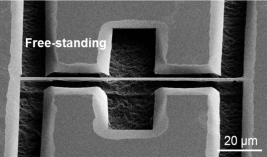We invest much time and effort into measuring and modeling the intrinsic thermal, electrical, and thermoelectric transport properties of individual nanostructures. Relevant material systems include metal and semiconductor nanobridges and nanowires and carbon and graphene based nanotubes and membranes. These structures are promising for applications ranging from energy conversion and photonic sources to data storage and semiconductor logic. While the measurements tend to be designed separately for each specific nanostructure, these measurements share fabrication and calibration methodologies and can generally be considered to belong to a single toolset.
A critical part of this research is lithography (including e-beam) and reactive and chemical etching performed at the Stanford Nanofabrication Facility (SNF). When possible and necessary we leverage leading edge nanofabrication procedures such as atomic layer deposition and solution synthesis. Recent examples in our current research include measurements of the thermal and electrical properties along metal bridges below 10 nm in thickness and studies of electrothermal transport in zinc oxide ZnO nanowires. In addition, we are investigating heat conduction properties along laterally periodic porous silicon nanostructures for applications in photonic and thermoelectric energy conversion. Earlier work applied these techniques to measure the electrical and thermal conductances along single wall carbon nanotubes.
Our earliest activities with these types of measurements date back to the 90’s and the groundbreaking work on measuring the thermal conductivity along silicon nanolayers. This work provided the first direct measurements of the phonon mean free path in this material. We also developed experimental structures for measuring the thermal conductivities of low-k dielectric passivation, which were implemented at Intel and other semiconductor firms as they rolled out this key technology in the early 2000’s. Finally, we have translated this measurement approach into our teaching at the undergraduate level with a heat conduction lab, which measured the thermal conductivity of silicon dioxide films.



